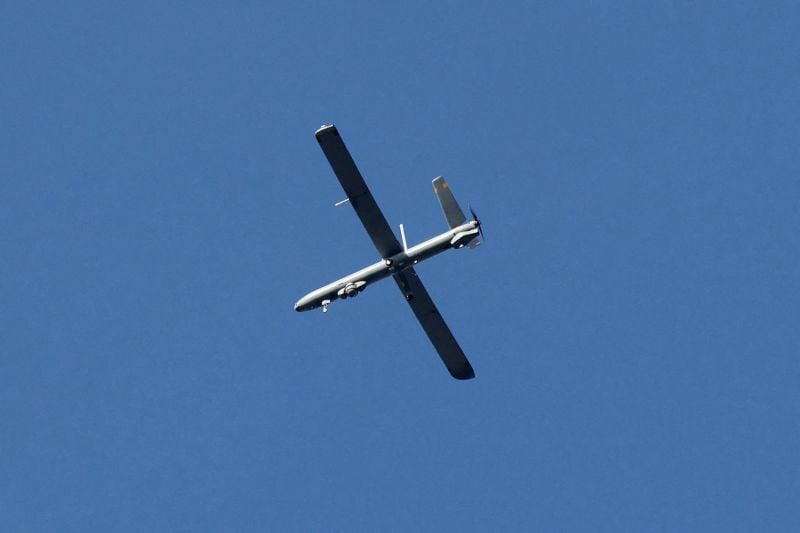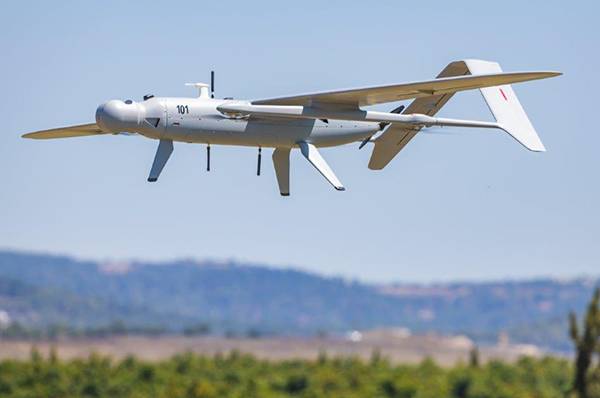
A picture taken from a position in southern Israel along the border with the Gaza Strip on Feb. 15, 2024 shows an Israeli military drone flying above the Gaza Strip, amid ongoing battles between Israel and the Palestinian militant group Hamas. (Credit: Jack Guez/AFP)
BEIRUT - This week, Hezbollah has shot down two Israeli drones in southern Lebanon.
On Thursday, the party said they targeted an unmanned aerial vehicle over the valley of the Aaziyyeh village (Sour), but it did not reveal what type of drone it was. On Monday, Hezbollah said it shot down an Israeli Hermes 450 drone over Lebanese territory with a surface-to-air missile.
Hezbollah, which is backed by Iran, said it downed or seized control of several Israeli drones in the months since it began exchanging fire with the Israeli military across Lebanon's southern border, in support of its Palestinian ally Hamas.
So which Israeli drones did Hezbollah shoot down or capture, and why is it important to their strategy? L'Orient Today explains...
Hermes 450
The Hermes 450 is a multi-payload drone made by Elbit Systems, an Israeli-based weapons manufacturer. It was the first Israeli drone to be hit and downed in Lebanon since the start of cross-border strikes on Oct. 8.
The medium-sized drone is designed for reconnaissance and surveillance missions and can fly for over 20 hours straight. Each of these drones costs about $2 million. Nicknamed Zik by the Israeli military, the drone can reach an altitude of almost 5.5 km. According to Hezbollah, the Hermes 450 is a multifaceted drone used for aerial interception and reconnaissance, locating, monitoring and attacking targets on land.
It’s also used for directing artillery fire, providing additional intelligence and fire support for land forces, and signal reconnaissance at the tactical level, the party said in a statement. It added that it is also used for mobilizing armed patrols to address emergency targets.
The Israeli army retaliated to this strike by launching their first airstrike in eastern Lebanon since the beginning of the war, targeting a warehouse in Baalbeck, which killed two members of Hezbollah. The warehouse is part of the Sajjad Project which sells food products to low-income families in Hezbollah's stronghold areas at prices lower than the market rate.
Skylark drone
In recent weeks, Hezbollah said it has seized control of several Skylark drones, which are smaller surveillance drones also made by Elbit. Hezbollah most recently announced it had intercepted an Israeli Skylark drone on Feb. 13, the second time in three days that the party claimed to have acquired this kind of drone. The group said in a statement that it is in "good condition."
The Skylark is a small, 45-kilogram drone, which is used by the Israeli infantry rather than its air force. It is easy to handle and does not require a runway for take-off. The drone is radio-controlled, and its capture could signify certain hijacking capabilities on the part of Hezbollah.
 A photo of the Elbit Systems Skylark I-eVTOL. Hezbollah did not specify which model of the drone they intercepted. (Credit: Elbit Systems website)
A photo of the Elbit Systems Skylark I-eVTOL. Hezbollah did not specify which model of the drone they intercepted. (Credit: Elbit Systems website)
Hezbollah's drone strategy "highly significant"
Military expert Riad Kahwaji told L'Orient Today that "it's highly significant that Hezbollah managed to down a drone that flies at such a high altitude."
According to Kahwaji, this reflects that “Hezbollah has an air defense system that can target planes that fly at such a high altitude,” adding that this undermines "Israel’s air superiority, its attempt to maintain full control of the sky and airspace and tits ability to allow its planes to move freely without the threat of any attack.”
“Lebanon is witnessing a security escalation today, both in terms of the intensity of the strikes and their depth,” Kahwaji said, explaining that in fact, “every time Hezbollah announces a new weapon, this in itself is an escalation.”
According to him, "We are on an escalator that has the potential to become a full-scale war."
But have we reached that point?
Not yet, but we are getting closer. However, Hezbollah seems to be trying to have a measured response, Kahwaji concluded.
Other incidents considered escalations and outside the "rules" between Israel and Hezbollah during the past almost five months of cross-border strikes have not led to a significant expansion of the conflict.